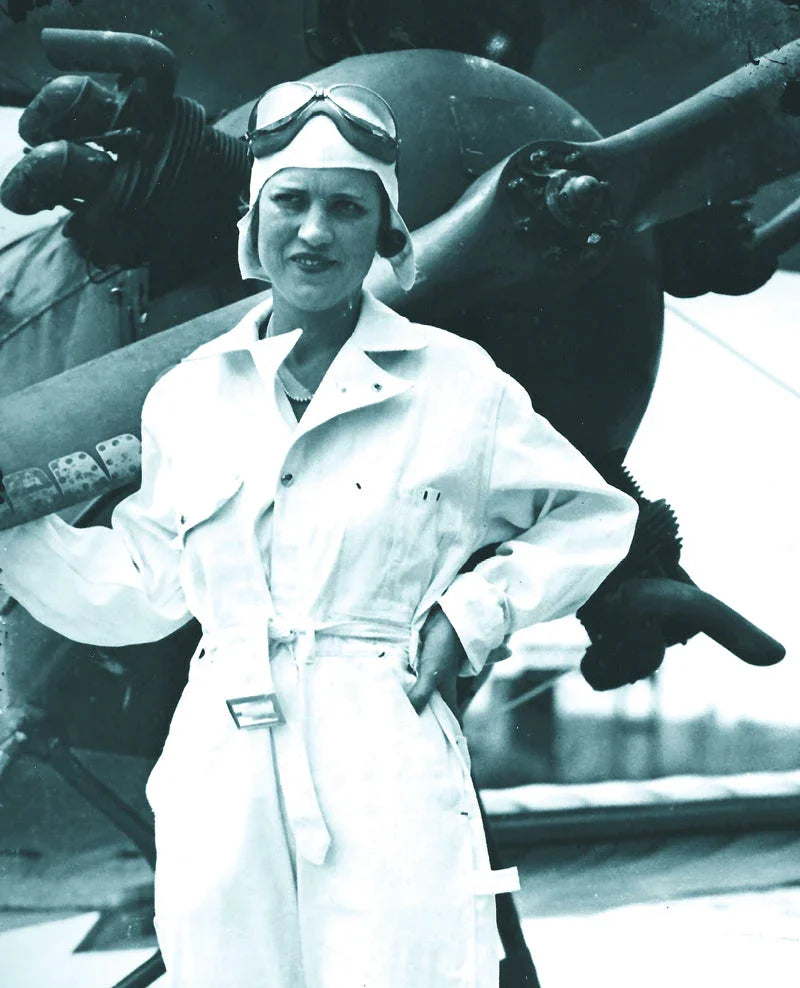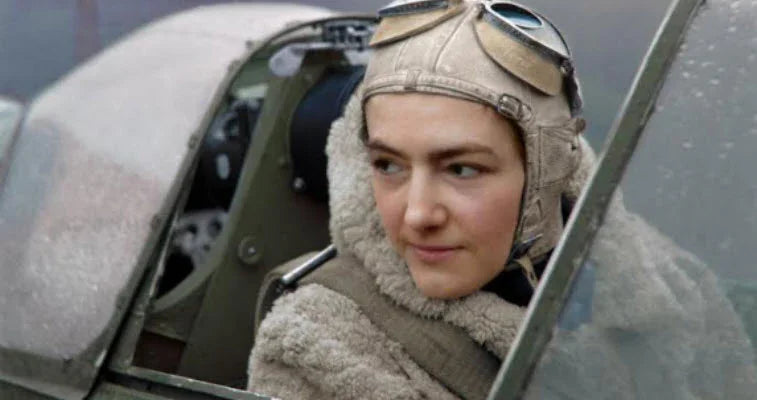Jacqueline Cochran, Aviatrix Extraordinaire! - Part Two

Jackie holding one blade of the prop on her "Lucky Strike Green" P-51B.
World War II has ended, and now Jacqueline Cochran, organizer and director of the WASP program, test pilot, record-setting race pilot, and adviser to generals and presidents, has decided to continue her quest for records.
The first item on her agenda is to purchase a new aircraft (or two), and purchases three P-51 Mustang fighters which had been modified for racing.
Many of us are familiar with the P-51 Mustang, the most common one being with the bubble canopy. However, the first variation was different, called the P-51B, with the pilot's canopy going straight back into the fuselage.
Reconstruction Finance Corporation (RFC)
When the Second World War ended the United States found itself with a large surplus of airplanes and began a program to dispose of tens of thousands surplus aircraft.
During the war, the U.S. manufactured about 294,000 aircraft for the war effort, of which 21,583 were lost in the U.S. due to test flights, ferrying accidents, and training accidents. Another 43,581 were lost en route to the war and in overseas operations.
The number of excess airplanes after the war was calculated as high as 150,000, and the initial plan was to store them. However, it became clear that the expense to store them was too great.

Aircraft awaiting sale, or the furnaces, at Kingman AAF after WWII
The Reconstruction Finance Corporation was formed to handle the disposal of these aircraft, and one of the solutions was to transfer a number of these aircraft to civilian control.
Jacqueline Cochran Cosmetics
Jackie continued to develop her line of cosmetics, and at least through the 1960s had a major presence in the cosmetic market.

Jacqueline Cochran ran a successful cosmetics company. This is one of her ads.
Jacqueline discussed her musings on makeup: "I'm feminine but I can't say that I was ever a feminist...I refused to get out of the plane [after a crash in Bucharest] until I had removed my flying suit and used my cosmetics kit.
That was feminine and it was natural for me.
It gave me the pick-me-up I needed and I wasn't ashamed to do it.
I didn't want to be a man. I just wanted to fly".
Though she says otherwise, Cochran's actions most definitely paint a feminist picture.
I'm seeing her reapplication of makeup following a crash as more of a coping technique and less "I need to look pretty".
Jacqueline Committed To Setting Records
Now that the war is over, Jacqueline is anxious to continue her flying, and in particular, wants to advance women in aviation and set women's aviation records.
Jackie's first P-51 is a P-51B-15-NA, manufactured by North American Aviation with the civil experimental registration of NX28388.
Jackie raced the "Lucky Strike Green" P-51B in the Bendix Trophy Race three times and used it to set four world speed records over distances from 3 to 2,000 kilometers.

The green P-51B-15-NA Mustang NX28388, #13, with P-38 drop tanks, at Metropolitan Airport, Van Nuys, California, August 1946.
Jackie flew NX288388 in the 1946 Bendix Air Race from Van Nuys, CA to Cleveland, OH, and while not winning the race she won a $ 5,500 prize.
The top speed for that race was set by Paul Mantz in a P-51C, completing the race in 4:34:14 elapsed time and an average speed of 435.501 mph.
Jackie placed second and completed the flight with an elapsed time of 4:52:00 averaging 420.92 mph. Because the wings of her aircraft were not modified to carry more fuel, Jackie had to carry two drop tanks.
When she dropped the nearly empty drop tanks over mountainous territory, the tanks did not release cleanly and struck the trailing edges of the wings. This created extra drag and time over the remainder of the race.
Jackie Sets A Record
On December 10, 1947, Jackie set a Fédération Aéronautique Internationale (FAI) establishing a Feminine International World Speed Record for 100 Kilometers in a Closed Circuit at Coachella, California, with an average speed of 755.668 kilometers per hour (469.549 miles per hour).

The Cerificate of Record for Jacqueline Cochran setting for 100 kilometers in a closed circuit.

Jackie in the cockpit of her "Lucky Strike Green" P-51B.
On May 22, 1948, again flying NX28388, Cochran set a Fédération Aéronautique Internationale and a U.S. National Aeronautic Association Record for Speed Over a Closed Circuit of 2,000 Kilometers Without Payload with an average speed of 447.470 miles per hour (720.134 kilometers per hour) over a 1,242.7 mile course from Palm Springs, California to a point near Santa Fe, New Mexico, and return.
Famed female aviator Katherine Stinson was the chief judge at the Pylon Turn west of Santa Fe.
Jackie broke the previous record, 708.592 kilometers per hour (440.299 miles per hour), which had been set by Lieutenant John J. Hancock, U.S. Air Force, with a Lockheed P-80A Shooting Star jet fighter, two years earlier. (FAI Record File # 8941)
Just think, she broke a two-year-old speed record set in a jet by a U.S. Air Force pilot in her modified racer P-51B!

2000 Kilometer Record Document for her record-setting flight on May 22, 1948.
And the records kept coming!
Over the years Jackie kept purchasing P-51 Mustang aircraft, and the first two she had were unfortunately involved with accidents while being raced by other male pilots.
NX28388 crashed while a Lockheed test pilot by the name of Sampson Held was ferrying Jackie's airplane back to California after she completed the 1948 Bendix Air Race. Held died as a result of this accident.
Beguine
Jackie's second P-51 Mustang was called Beguine, a radically-modified P-51 Mustang NX4845N.

The modified Mustang air racer, Beguine.
In 1949 Jackie purchased the Beguine at the insistence of Bill Odom who wanted to fly it in the Sohio Trophy Race and the Thompson Trophy pylon races, both of which were pylon races flown over a 15-mile, seven-turn course in Cleveland, OH.
Odom had never flown in a pylon race before, but he had gained fame for setting a number of record flights.
Jackie also planned to fly the Beguine herself in the 1950 Bendix Trophy Race.
Bill Odom won the Sohio Trophy Race with an average speed of 388.393 miles per hour.
The Thompson Trophy Race on September 5, 1949 was different. He qualified for the race with a speed of 405.565 miles per hour, and at the start of the race, Odom quickly took the lead.
As he approached Pylon 4 the Beguine rolled upside down and crashed into a house near the airport, setting it on fire and resulting in the death of Odom, Jeanne Laird, and her 13-month-old son Craig.

The Laird's home after Odam crashed into it with the P-51 Beguine on 9-5-1949.
Jackie Gets Yet Another P-51 Mustang
Undeterred, Jackie seeks yet one more P-51C, this time the one owned by movie star James Stewart.
During the Second World War, Jimmy Stewart (already a commercial pilot) enlisted in the USAAF and flew 20 B-24 missions.
He was stationed in Europe through the end of the war, receiving two Distinguished Flying Crosses, four Air Medals, a Presidential Unit Citation, and the French Croix de Guerre.

Jimmy Stewart and Joe De Bona beside their P-51C "Thunderbird" surrounded by parts removed and/or replaced.
Jimmy Stewart's Mustang was called "Thunderbird", an Unlimited Class North American Aviation P-51C, N5528N was acquired by Jackie Cochran on December 19, 1949.

Actor Jimmy Stewart's rebuilt P-51C named "Thunderbird" in flight.
That same day, Jackie Cochran flew her new airplane to two Fédération Aéronautique Internationale (FAI) World Records for Speed Over a 500 kilometer Closed Circuit Without Payload, and a U.S. National Aeronautic Association record, with an average speed of 703.275 kilometers per hour (436.995 miles per hour).
On April 9, 1951, Jackie flew the Thunderbird at an average speed of 464.374 mph over a straight 16-kilometer course in India, CA for yet another record.

Jackie sets yet another record in her P-51C "Thunderbird".
Jackie Was Not Done Yet!
Over the following years, Jackie flew a lot of different aircraft setting many records.
She flew a Canadair CL-13 Sabre Mk.3 on Rogers Dry Lake, Edwards AFB in May of 1953, breaking the speed of sound.

In 1961 she flew a Northrop T-38 Talon to set more records.

On April 22, 1962, she set another record in a Lockheed L-1329 JetStar, N172L.

She then went on to fly twice the speed of sound (yes, setting yet another record) in 1964.

Here are a number of her accomplishments over her aviation career:
- Flew in the London, England to Melbourne, Australia race in 1934.
- In 1935, she became the first woman to fly in the Bendix Trophy Race, which she later won in 1938.
- Became the first woman to make a blind instrument landing in 1937.
- Set new women’s records during 1939-40, in altitude, and open class speed.
- Was the first woman to fly a bomber across the Atlantic Ocean, leading to the formation of the Women’s Air Force Service Pilots (WASP) program for which she received the Distinguished Service Medal.
- Received the Harmon Trophy in 1950 as the Aviatrix of the Decade.
- In 1953, she became the first woman to exceed the speed of sound and exceeded Mach 2 in 1964
- When she died in 1980, she held more speed, altitude and distance records than anyone in the world, male or female.
List of Notable Records:
- First woman to break the sound barrier
- First woman to reach Mach 2
- First woman to land and take off on an aircraft carrier
- First woman to pilot a jet aircraft on a transatlantic flight
- First woman to make a landing solely by the use of instruments
- Only woman to be president of the Fédération Aéronautique International (FAI)
- First pilot to fly above 20,000 feet with an oxygen mask
- First woman to enter the Bendix Transcontinental Air Race
I hope you enjoyed this trip through some of the history of aviation. If you enjoyed this trip, and are new to this newsletter, sign up to receive your weekly newsletter here: Subscribe here!







1 comment
Mike Posey
Leave a comment
This site is protected by hCaptcha and the hCaptcha Privacy Policy and Terms of Service apply.